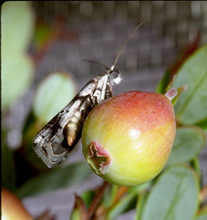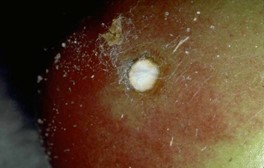Managing Cranberry Fruitworm (2011)
Cranberry fruitworm is one of the most serious and challenging insect pests in MA and enjoys this high pest status owing to several factors. It is very difficult to monitor egg infestation and moth flight may last many weeks. Larval infestation becomes apparent only after the larva has entered green berries and they begin to prematurely redden. Once inside the fruit, insecticide treatments are ineffective and the larva is protected from natural enemies. Pressure in commercial settings is often high and there is a very low threshold for injury by handlers. Up until recently, management has been limited to broad-spectrum organophosphate and carbaryl sprays that negatively impact natural enemies.
New spray timings and compounds are moving into the UMass Cranberry Chart Book, see below.
Biology
In early to mid June, moths begin to emerge. Significant flight levels typically occur just before and during fruit set, typically in the first 2 weeks of July; a second small peak may follow in 2-3 weeks. Scattered flight may continue through August or even September. Females tend to mate multiple times and along with males, move throughout the bog habitat; they are active in the forest understory and high in trees surrounding the cranberry bed in late evening. Studies show that counts of CFW in the woods surrounding a bed are often considerably higher than those on the bog.
Moths become active around dusk. In cases of high infestations, moths can be seen in jerky, low flight on the bed during the day, flushing up when disturbed. The egglaying pattern is clumped, with greater frequencies of eggs than expected near weedy areas and the bog margin.
Newly-hatched larvae enter the fruit in less than 2 h, typically leaving the calyx, moving to the top of the berry, and aligning their body along the berry pedicel as they eat into the top of the fruit. For sprays targeting larvae, this is the narrow window of opportunity. The larva’s entry is barely visible to the unaided eye, but because the larva closes the entrance with white silk, a white dot on the top of the berry is an indicator of infestation. On rare occasions, larvae remain in the calyx and enter here.


Left: Female moth on fruit preparing to lay egg inside rim of calyx cup.
Right: Recently laid eggs are green and within 1-2 days, viable eggs show a reddish line (arrow points to developing egg) as they mature. If an egg is black, it has been parasitized and killed by a natural enemy (wasp).
Early instars excavate the seeds first and do not move until much of the fruit flesh is consumed and replaced with frass (brownish, soft fecal pellets). As the larva fills the berry with frass (Figure 2), it turns red prematurely, providing a clear sign of infestation. The larva sometimes moves from one berry directly into another at the point of berry contact (Figure 5).
All 1st and 2nd instar larvae construct a silken closure at the surface of the berry where they entered the fruit (Figure 3); most intermediate instars also do so, but the final (5th) instar very rarely does.

Mature larva may reach 12-16 mm; near completion of development, they have a reddish tint on the rear portion of the body. When fully mature, the larva drops to the bog floor and spins a silken cell of silk that integrates sand and trash, called a hibernaculum

The larva’s silken-sealed entrance on fruit

Infested fruit turn red prematurely, starting at the top, and then eventually shrivel up
Management
The previously infested berries often cling to the vines as husks until the following year. Yield is decreased by the 2-3 large berries or 6-7 small berries required by each larva to complete development. Injured berries gradually shrivel like raisins (Figure 4) and some late-larvae may be picked up at harvest.
Sampling
Male flight may be monitored with wing traps baited with a blend of (E,Z)-8,10-pentadecadien- 1-ol and (E)-9-pentadecen-1-ol acetate and placed high, 1 meter above the canopy—but this is not a recommended sampling technique (see Figure 6). For the early cultivars (Stevens, Early Blacks, Ben Lears), trap data do not provide useful information regarding spray timing in cranberry: there is no consistent relationship between male moth activity and female egglaying activity in cranberry. The earliest emerging females appear well before berries have set; significant egglaying does not occur until pinheads have begun to enlarge (ca 3 mm). To monitor for eggs, labor-intensive visual inspections of berry samples have been employed in IPM programs. A methodology to detect a <1% egg infestation with a high degree of precision was developed in MA and involves collection of 50 randomly picked berries/acre with action thresholds based on sample size (see the UMass Cranberry Chart Book).
Spray Timing
The lack of adequate and efficient monitoring techniques, coupled with the fact that fruitworm pressure is routinely much higher than the tolerance for infested fruit, has lead to prophylactic spray recommendations based on crop phenology. Our recent research and the availability of compounds that will not impact pollinators have lead to reassessment of management strategies. Currently, we are recommending that a first spray is applied at 50% out-of-bloom (when half of the flowers have set) for all early varieties and for Howes, we recommend that the first spray be delayed until 7-9 days after 50% out-of bloom. A second spray 10 days later may be applied for all of the cultivars. While conventional broad-spectrum insecticides (Diazinon, Sevin) are effective, new options protect beneficial insects and are clearly the best choice. Delegate, the new diamides, or very low-gallonage applications of Intrepid are highly effective alternatives with excellent residual activity.
Biological and Cultural Controls
Selective insecticides will aid in conservation of natural enemies, particularly Trichogramma spp. egg parasitoids that are abundant in mid to late season and the braconid wasp, Phanerotoma franklini Gahan, which is found in large numbers on untreated bogs. The wasp larva develops inside the host CFW larva, overwinters in the host, and then emerges the following spring.
Every third year, a late water flood in cranberry (a one-month flooding of the beds in mid April) can eliminate cranberry fruitworm populations. Lengthy fall floods are also effective at suppressing populations. Preliminary work with seeded overwintering stage cohorts (late stage larva in a hibernacula) on beds flooded for 3-4 weeks in September-October showed substantially lower moth emergence, but more work is required to determine if there is a concomitant stress on the flooded vines. In any flooding scenario, beds may be repopulated by moths from neighboring untreated beds, so it is prudent to consider flooding on an area-wide basis or to monitor berries for eggs on a regular basis.

Two berries, lightly silked together by a late instar larva. The larva has travelled from the right to left berry, affording it protection from both natural enemies and chemical applications.

2009 pheromone trap captures of male moths for Stevens (ST), Early Blacks (EB) and Howes at a site where all three cultivars were planted. For Stevens and Early Blacks, note early onset of male flight and high counts in early June (female flight is known to be parallel, based on other studies). 50% out-out-bloom (OOB), when half the flowers have set fruit, occurred right around July 1. We recorded significant egglaying just prior to and at 50% OOB for Stevens and Early Blacks. Note later flight for Howes; we found that egglaying was also later. These trends have been consistent across years and we have moved the timing of sprays—and are recommending the new chemistries (Delegate, new diamides, Intrepid in very low gallonage)—to 50% OOB for the early cultivars and 7-10 days after 50% OOB for Howes.